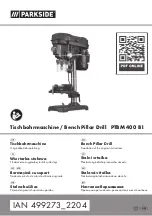
6 ENGLISH
ASSEMBLY
CAUTION:
Always be sure that the tool is
switched off and unplugged before carrying out
any work on the tool.
Installing top grip (auxiliary handle)
►
Fig.3
Screw the top grip on the tool securely.
Installing back grip (country
specific)
►
Fig.4:
1.
Leaf spring
2.
Rear handle
3.
Boss
Pull off the cap from the tool housing. Insert the leaf
springs into the groove of the handle part that has the
bosses. Then attach them to the bottom of the tool
housing.
►
Fig.5:
1.
Rear handle
2.
Screw
Attach both of the handle parts and tighten them with
the screws securely.
Installing or removing drill bit
►
Fig.6:
1.
Drill chuck
2.
Chuck key
To install the drill bit, place it in the drill chuck as far as
it will go. Tighten the chuck by hand. Place the chuck
key in each of the three holes and tighten clockwise. Be
sure to tighten all three chuck holes evenly.
To remove the drill bit, turn the drill chuck key counter
-
clockwise in just one hole, then loosen the chuck by
hand.
After using the chuck key, be sure to return it to the
original position.
OPERATION
Drilling operation
►
Fig.7
Always use the top or back grip (auxiliary handle) and
firmly hold the tool by top or back grip and switch handle
during operations.
Drilling in wood
When drilling in wood, the best results are obtained
with wood drills equipped with a guide screw. The guide
screw makes drilling easier by pulling the drill bit into
the workpiece.
Drilling in metal
To prevent the drill bit from slipping when starting a
hole, make an indentation with a center-punch and
hammer at the point to be drilled. Place the point of the
drill bit in the indentation and start drilling.
Use a cutting lubricant when drilling metals. The excep
-
tions are iron and brass which should be drilled dry.
CAUTION:
Pressing excessively on the tool
will not speed up the drilling.
In fact, this excessive
pressure will only serve to damage the tip of your drill
bit, decrease the tool performance and shorten the
service life of the tool.
CAUTION:
Hold the tool firmly and exert care
when the drill bit begins to break through the
workpiece.
There is a tremendous force exerted on
the tool/drill bit at the time of hole break through.
CAUTION:
A stuck drill bit can be removed
simply by setting the reversing switch to reverse
rotation in order to back out. However, the tool
may back out abruptly if you do not hold it firmly.
(For Model M6201)
CAUTION:
Always secure workpieces in a
vise or similar hold-down device.
CAUTION:
Avoid drilling in material that you
suspect contains hidden nails or other things that
may cause the drill bit to bind or break.
MAINTENANCE
CAUTION:
Always be sure that the tool is
switched off and unplugged before attempting to
perform inspection or maintenance.
NOTICE:
Never use gasoline, benzine, thinner,
alcohol or the like. Discoloration, deformation or
cracks may result.
Replacing carbon brushes
►
Fig.8:
1.
Limit mark
Check the carbon brushes regularly.
Replace them when they wear down to the limit mark.
Keep the carbon brushes clean and free to slip in the
holders. Both carbon brushes should be replaced at the
same time. Use only identical carbon brushes.
1.
Use a screwdriver to remove the brush holder
caps.
2.
Take out the worn carbon brushes, insert the new
ones and secure the brush holder caps.
►
Fig.9:
1.
Brush holder cap
To maintain product SAFETY and RELIABILITY,
repairs, any other maintenance or adjustment should
be performed by Makita Authorized or Factory Service
Centers, always using Makita replacement parts.
Summary of Contents for M6200
Page 2: ...1 2 Fig 1 2 1 3 Fig 2 Fig 3 1 2 1 3 3 Fig 4 1 2 2 Fig 5 2 1 Fig 6 Fig 7 1 Fig 8 2 ...
Page 3: ...1 Fig 9 3 ...
Page 41: ...41 ...
Page 42: ...42 ...
Page 43: ...43 ...







































